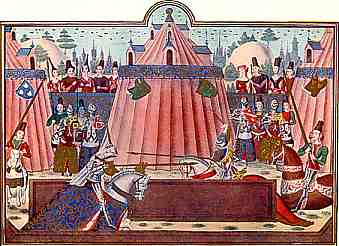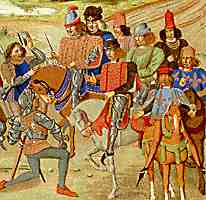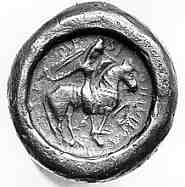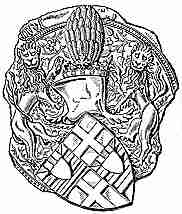






If you are looking at this page without frames, there is more information about medieval writing to be found by going to the home page (framed) or the site map (no frames).
| Works on Heraldry (3) | |||||
| One might think of heralds these days as people who wander around on ceremonial occasions in strange costumes and who have a detailed knowledge of very intricate aspects of visual depiction. Around the time of the Hundred Years' War, they had a more lively role. On good days they got to officiate at tournaments, those supposedly chivalric but very rough medieval sports being occasions for great displays of personal heraldic devices, and possibly one of the reasons that these developed in complexity. | |||||
 |
A depiction of the famous tournament at St Inglevere, where the French knights supposedly held the lists for thirty days against the English, after a miniature in a manuscript of Froissart's chronicles in the British Library. | ||||
| The above copy of a miniature gives something of the colour and light and movement of a tournament, conducted during a truce in the Hundred Years' War. They couldn't bear to actually stop fighting. The display of heraldry appears on the costumes of the knights, their horse accoutrements and on the banners and shields hanging all around the place. Very jolly stuff. | |||||
| On bad days they had more alarming duties. During battles they acted as messengers. They had to stroll into the heart of the enemy camps to deliver their messages. The rules said they were not to be harmed, and they were supposed be unarmed, and to do no sneaky peeking at what the enemy was up to. Naturally, they had to be very readily recognised so that no nasty accidents would ensue, so they wore loud, garish tabards decorated with the arms of their king or lord, in the hope that nobody would shoot them before they realised who they were. Other fun jobs on the battle field included keeping a record of the knightly dead and triumphally waving captured banners. |
 |
||||
| Charles VI meets some armed Parisians. His heralds are with him on the right of the picture. After a Froissart manuscript (Bibliothèque nationale ms 2644). | |||||
| It must have been on really quiet days that they got to formulate the rules and vocabulary of heraldry, and to ensure that arms being borne by individuals were legitimate. By the late 13th century, there were two kings of arms with jurisdiction over the north and south of England. In 1415 King Henry V created the Order of the Garter, and Garter, King of Arms became the principal of the heralds. By this time heraldry was a literate industry with its own apprentices, called Poursuivants, recording all matters to do with heraldry. A College of Arms, with its own charter, was not founded until 1484 by King Richard III, who, as we all know, lost his horse, his throne and his life at the battle of Bosworth Field, resulting in the end of the middle ages in England. | |||||
| Strange to tell, not all medieval institutions died with the arrival of the Tudors. The College of Arms was refounded in 1555 in the reign of Queen Mary and powers on to this day, its quaint vocabulary and rituals still relevant to some corner of our modern minds. In the 16th century, the heralds carried out visitations around England and Wales to check on the legitimacy of those bearing arms and to record the armorial designs. Such records survive in the College of Arms and the British Library. | |||||
| Coats of arms were not only useful for knowing who was being biffed by whom in battle or at play, they were used in the process of manuscript making to validate documents by seal. Interestingly, the earliest royal or knightly seals did not bear coats of arms. The image of the monarch seated in majesty or, as also with the aristocracy, mounted on a horse, was identified by the legend, or inscription, around the seal rather than by heraldic devices. |
 |
||||
| Obverse of the seal of William the Conqueror. | |||||
| The earliest knightly equestrian seal which shows evidence of a coat of arms dates from the 12th century, when we know these things were being adopted and codified. However, the general rule at this time was that an anonymous knight sat on his horse and was identified by the inscription surrounding him. It does suggest that the belligerent use of arms predates its more civilised judicial use. |
 |
||||
| 12th century equestrian seal of Ralph de Cuningburgh (British Library, add. charter 70691). By permission of the British Library. | |||||
| It seems to have been the lesser knights and gentry who, not qualifying for the equestrian seal, used various visual devices on their seals. Sometimes these later became part of a formal coat of arms. Meanwhile, the senior aristocracy began adding their coats of arms to their seals, with some of the designs becoming very elaborate in, you guessed it, the 14th century. | |||||
 |
This rather stunning late 13th century seal has a clear and simple depiction of the owner's arms on his shield as well as on his horse trappings. The rider wears a hefty tilting helm with an elaborate crest, elements which were also included in later medieval armorials. | ||||
| Seal of Alexander de Balliol of 1292. | |||||
| Eventually, some seals bore very elaborate heraldic designs incorporating all the elements of the full achievement of arms. This example has shield, helm with crest and mantling and two lion supporters. As the seals are attached to handwritten documents, they become manuscript evidence themselves for the development and diversity of heraldry. |
 |
||||
| 15th century seal of Edmund de Mortimer, Earl of March. | |||||
| More information about the use of heraldic devices on seals can be found in the Seals section of this web site. | |||||
| By the later 15th and 16th centuries, the bearing of arms was no longer tied to feudal obligation to the king, but to more modern concepts of social worth. In an increasingly mercantile age, being filthy stinking rich was a reasonable criterion, as was the holding of important offices in the city, like Lord Mayor of London. Arms were also granted to corporate bodies such as university colleges and guilds, indicating their significance in the new social order. | |||||
| Grant of arms to the Salters' Company of London made in 1530 (College of Arms MS L6, f.17). |  |
||||
| Note that the design of the arms has become pictorial rather than abstract or purely symbolic. The elegant salt pots with salt streaming out of them do look a little cartoonish. I guess there are only so many things you can do with stripes, crosses, wiggles and imaginary animals. | |||||
| However, as with so many things in the medieval era, much is actually expressed in other visual media. If we can read things other than documents, we can learn so much more. | |||||
|
|
|||||
|
|
|||||
|
If you are looking at this page without frames, there is more information about medieval writing to be found by going to the home page (framed) or the site map (no frames). |
|||||